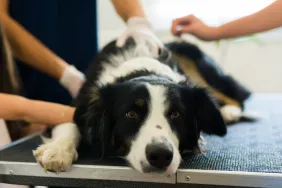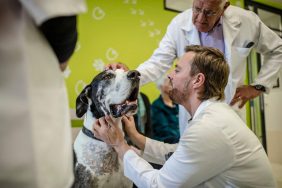This article is brought to you courtesy of the National Canine Cancer Foundation.
See more articles on canine cancer.
Donate to the Champ Fund and help cure canine cancer.
Description
Testicular tumors account for 90% of all cancers originating from the male reproductive system. Testicular tumors mostly develop from three cell lineages although testicular cancers may also arise from other cell types including hemangiomas, granulosa cell tumors, teratomas, sarcomas, embryonal carcinomas, gonadoblastomas, lymphomas, rete testis and mucinous adenocarcinomas.
The primary testicular tumors consist of interstitial cell tumors formed from interstitial cells of Leydig (secrete male hormone testosterone), sertoli cell tumors formed from the sustentacular cells of Sertoli (nurtures the developing sperm cells through the process of spermatogenesis) and seminomas formed from the spermatic germinal epithelium (innermost layer of the testicle). These tumors occur at a proximal interval of each other and most of the testicular cancers consist these tumors as a whole. Around 40% of dogs have more than 1 primary testicular tumor. Primary tumors rarely metastasize. However, the metastatic sites may include regional draining lymph nodes, liver, pulmonary parenchyma, kidneys, spleen, adrenals, pancreas, skin, eyes and central nervous system.
Although intact canine males with a median age of 10 years are highly predisposed, breeds at an increased risk include Boxer, German Shepherd, Afghan Hound, Weimaraner and Shetland Sheepdog.
Causes
Dogs with retained or undescended (testes that do not descend into the scrotum) testes have a propensity for Sertoli cell tumors and seminomas. Studies have indicated that cryptorchidism (absence of one or both testes from the scrotum) is one of the most important contributing factors to testicular cancer.
Apart from these age, breed and exposure to environmental carcinogens are other factors that attribute to tumorogenesis. Seminomas were commonly found among military service dogs who fought the Vietnam War. Studies have revealed testicular changes like testicular hemorrhage, epididymitis (Inflammation of the epididymis. It is a curved structure at the back of the testicle where the sperm is matured and stored), orchitis (inflammation, swelling and frequent infection of the testes), sperm granuloma (it is a lump of sperm that appears along the vasa deferentia or epididymedis in vasectomized men), testicular degeneration (most frequent cause of male infertility) and seminomas in these dogs. However, exposure to chemicals like herbicides, dioxin, or tetracycline are believed to have triggered tumorogenesis.
Symptoms
Testicular tumors can be manifested in several forms like atrophy of the contralateral normal testicle, regional mass effects in the abdominal cavity or inguinal space, feminization, bilaterally symmetric alopecia, hyperpigmentation (darkening of the skin), a pendulous prepuce (suspended foreskin that covers the skin), gynecomastia (development of abnormally large mammary glands in males), galactorrhea (flow of milk from the breast irrespective of childbirth), atrophic penis and squamous metaplasia (benign changes in the epithelial linings of certain organs of the body) of the prostrate due to hyperestrogenism (excessive secretion of estrogen in the body). Hyperestrogenism may also cause blood dyscrasias (condition in which any of the blood components is abnormal), bone marrow hypoplasia (underdevelopment or incomplete development of a tissue or organ), pancytopenia (reduction in the number of white blood cells, red blood cells as well as platelets) which could prove fatal.
Other associated symptoms may include hematuria (blood in the urine), spermatic cord torsion (cord that supplies blood to a testicle is twisted) and hemoperitoneum (presence of blood in the peritoneal cavity).
Diagnostic techniques
The diagnostic work-ups may include fine-needle aspiration with cytology, rectal palpation, complete blood count, abdominal ultrasound and testicular ultrasonography.
Rectal palpation denotes regional lymph node enlargement if there is any. Palpation of the prostrate gland is mandatory.
Complete blood count is taken for examining hematologic abnormalities associated with hyperestrogenism like leukopenia (decrease in the number of white blood cells), thrombocytopenia (platelets count is relatively low) and anemia.
With the help of abdominal ultrasound scan, doctors identify retained testes in the inguinal region or abdominal cavity. It also helps them to examine the regional lymph nodes, evaluate distant metastasis and changes in the prostrate due to secondary to hormonal imbalances.
Fine needle aspiration cytology is useful in screening for regional and distant metastasis.
And finally, testicular ultrasonography is helpful in differentiating malignant conditions from non-malignant conditions like orchitis, epididimytis and testicular torsion.
Treatment
Most of the primary testicular tumors are non-metastatic. Orchiectomy (removal of one or more testicles or testes) with scrotal ablation is the treatment of choice for dogs with localized tumors. Since primary testicular tumors rarely metastasize, there is not enough information on their management procedures although there have been reports of systemic chemotherapy and radiation therapy.
Prognosis
Dogs treated with orchiectomy have a good prognosis. However, the outcome for dogs with bone marrow hypoplasia secondary to hyperestrogenism is guarded. According to some reports, dogs treated with system chemotherapy showed a median survival time of 5 months to 31 months.
Reference
Withrow and MacEwen’s Small Animal Clinical Oncology – Stephen J. Withrow, DVM, DACVIM (Oncology), Director, Animal Cancer Center Stuart Chair In Oncology, University Distinguished Professor, Colorado State University Fort Collins, Colorado; David M. Vail, DVM, DACVIM (Oncology), Professor of Oncology, Director of Clinical Research, School of Veterinary Medicine University of Wisconsin-Madison Madison, Wisconsin.









